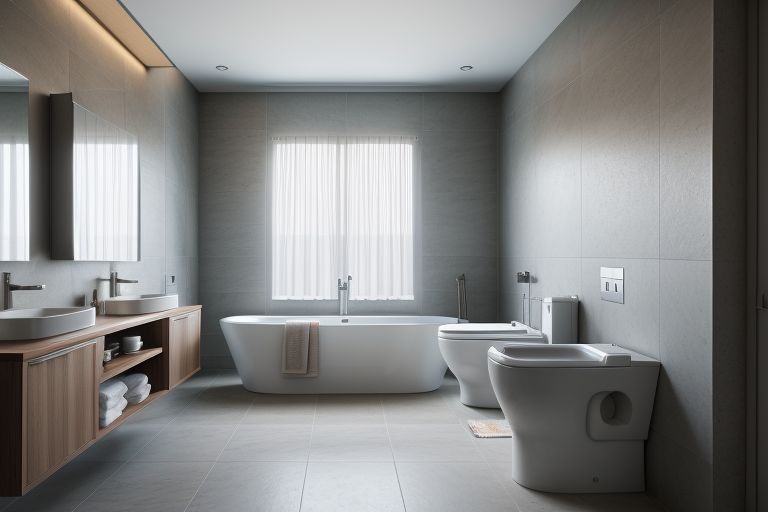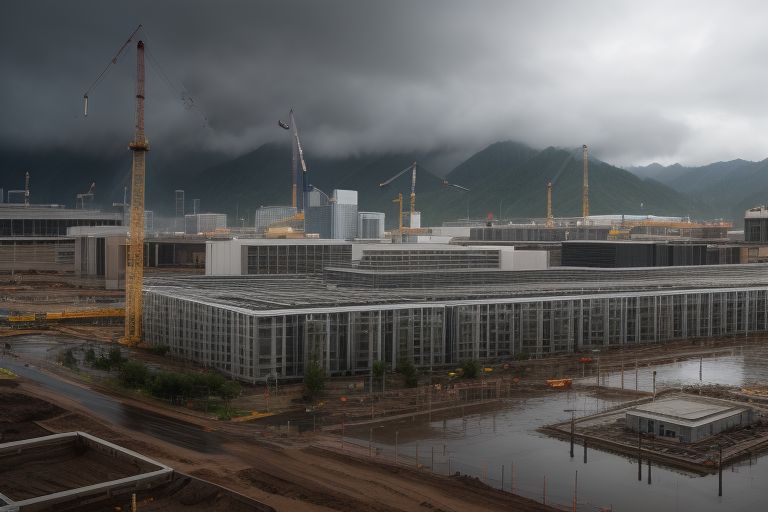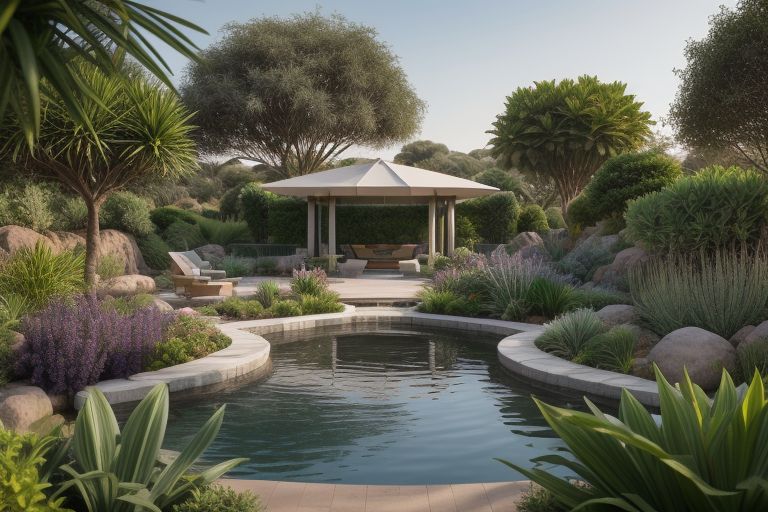- [email protected]
- +254 723 065019
- Mon - Sat 9:00 AM - 5:00 PM
- Login or Register
- Favorites
4.1 Water Conservation Techniques
Lesson 4.1: Water Conservation Techniques
Welcome to Lesson 4.1: Water Conservation Techniques!
In this lesson, we will delve into the essential strategies and technologies for conserving water within building design and operation. Water conservation is a critical aspect of sustainable building practices, especially as the demand for fresh water continues to rise and natural water sources become increasingly strained.
Water conservation techniques not only help in reducing overall water usage but also contribute to lower utility bills, extended lifespan of plumbing systems, and positive environmental impact. By implementing effective water-saving measures, buildings can minimize their ecological footprint and promote more responsible use of this vital resource.
We will explore a range of water conservation methods, including:
- Efficient Fixtures and Fittings: Learn about low-flow and high-efficiency fixtures that reduce water consumption without compromising performance.
- Rainwater Harvesting Systems: Discover how capturing and reusing rainwater can supplement potable water supplies and reduce overall demand.
- Greywater Recycling: Understand how recycling greywater from sinks and showers can provide water for irrigation and other non-potable uses.
- Water-Efficient Landscaping: Explore techniques for designing landscapes that require less water while still maintaining aesthetic appeal.
Objective:
By the end of this lesson, learners will:
- Understand Key Water Conservation Techniques: Gain knowledge of various methods for conserving water in construction projects and buildings, including efficient fixtures, rainwater harvesting, greywater recycling, and water-efficient landscaping.
- Identify Effective Water Management Practices: Learn how to implement strategies that reduce water use, enhance water efficiency, and manage water resources effectively within a building.
- Evaluate Water Conservation Technologies: Become familiar with the latest technologies and systems designed to optimize water use and minimize waste.
- Apply Water-Saving Measures: Develop the ability to incorporate practical water conservation techniques into building designs and operations to achieve sustainable and resource-efficient outcomes.
By mastering these objectives, you will be equipped to make informed decisions and contribute to more sustainable and water-efficient building practices.
1. Introduction to Water Conservation
Water conservation is a critical component of sustainable building practices and environmental stewardship. As the global demand for water increases and natural water sources become more stressed, implementing effective water conservation techniques has become essential for responsible building design and operation.
This section will introduce the fundamental concepts and importance of water conservation in the context of construction and building management. We will explore the reasons behind the need for water conservation, the benefits it offers, and the various techniques that can be employed to achieve significant water savings.
Understanding and applying water conservation strategies not only helps in reducing environmental impact but also contributes to lowering operational costs and enhancing the overall sustainability of buildings. By the end of this section, you will have a solid foundation in water conservation principles and be prepared to explore specific techniques and technologies designed to optimize water use in construction and building operations.
Key Points:
Water conservation encompasses strategies and practices designed to reduce water use and minimize waste. These methods aim to ensure a sustainable water supply and mitigate environmental impacts associated with excessive water consumption.
a. Importance:
Implementing water conservation techniques is essential in the face of escalating water scarcity issues driven by growing populations and climate change. Effective water management not only supports sustainability but also offers practical benefits:
- Reduce Utility Costs: By lowering water consumption, buildings can significantly cut water bills and reduce overall operational expenses. This is particularly important for both residential and commercial properties where utility costs can form a substantial portion of the budget. Adopting water-efficient technologies and practices can lead to immediate financial savings.
- Preserve Local Water Resources: Effective water conservation helps safeguard the availability and quality of local water supplies. This preservation is crucial for sustaining ecosystems that depend on a balanced water cycle and for ensuring that communities have reliable access to clean water. By reducing water use, we contribute to the health of rivers, lakes, and aquifers, thereby supporting environmental stability and resilience.
b. Scope:
This lesson will delve into a variety of water-saving techniques that can be applied in different contexts to enhance water efficiency and promote sustainability:
New Construction: Learn how to integrate water-efficient designs and technologies during the building process. This includes selecting low-flow fixtures, incorporating rainwater harvesting systems, and designing landscapes that minimize water use. Implementing these strategies from the outset ensures that new buildings are both environmentally friendly and cost-effective.
Existing Buildings: Explore methods for upgrading existing structures to improve water efficiency. This involves retrofitting older fixtures with modern, water-saving alternatives, adopting smart water management practices, and optimizing landscaping to reduce water consumption. These updates can significantly lower water use and operational costs while enhancing the building’s overall sustainability.
By mastering these techniques, you will be prepared to implement effective water conservation measures, whether you are working on new construction projects or improving the efficiency of existing buildings.
Reflection Element:
Reflect on why water conservation is increasingly important in today’s construction practices and building management.

2. Water-Efficient Fixtures and Appliances
In the quest for sustainability and conservation, water-efficient fixtures and appliances play a pivotal role. These innovations are designed to reduce water consumption without compromising performance, making them essential components in modern water conservation strategies.
- Water-Efficient Fixtures: These include a range of devices such as low-flow faucets, toilets, and showerheads, which are engineered to use significantly less water than traditional fixtures. By incorporating these fixtures, buildings can drastically cut their water usage, contributing to lower utility bills and a reduced environmental footprint.
- Water-Efficient Appliances: From dishwashers to washing machines, water-efficient appliances are designed to optimize water use while maintaining high performance. These appliances use advanced technologies to minimize water consumption during operation, leading to substantial savings over time.
In this section, we will explore various types of water-efficient fixtures and appliances, their benefits, and how they can be effectively integrated into both new and existing buildings. Understanding these elements will enable you to make informed decisions that enhance water conservation and support sustainable building practices.
Key Points:
Water-efficient fixtures and appliances are essential tools in reducing indoor water use and minimizing overall consumption. They help conserve water, lower utility bills, and support sustainable building practices.
a. Low-Flow Toilets
Low-flow toilets are specifically engineered to minimize water usage per flush. Traditional toilets typically use 1.6 gallons of water per flush, whereas low-flow models use 1.28 gallons or less. This reduction in water use helps conserve valuable resources and reduce overall water consumption.
Benefits:
-
- Substantial Water Savings: By using less water per flush, low-flow toilets significantly decrease the amount of water consumed, contributing to lower water bills.
- Performance Efficiency: Modern low-flow toilets are designed to maintain high performance standards, ensuring effective waste removal without compromising user satisfaction.
- Environmental Impact: Reducing water usage lessens the burden on local water supplies and helps in the conservation of water resources, which is crucial in areas facing water scarcity.
Example: Dual-flush toilets are a popular type of low-flow toilet that offers two flush options. Users can select a lower volume flush (usually around 0.8 gallons) for liquid waste and a higher volume flush (around 1.6 gallons) for solid waste. This design allows for optimized water use based on the type of waste being disposed of, further enhancing water conservation efforts.
b. Low-Flow Showerheads and Faucets
Low-flow showerheads and faucets are engineered to reduce water consumption by limiting the flow rate. Showerheads are typically designed to use 2.0 gallons per minute (GPM) or less, while faucets are limited to 1.5 GPM or less. These fixtures help achieve significant reductions in water use without sacrificing performance.
Benefits:
-
- Reduced Water Consumption: By limiting the flow rate, low-flow fixtures cut down on the amount of water used, which can lead to considerable savings on water bills.
- Energy Savings: With less water being used, there is a reduced need for heating water, resulting in lower energy consumption and cost savings.
- Maintained Performance: Modern low-flow fixtures are designed to deliver a satisfying user experience by maintaining adequate water pressure and performance despite the reduced flow rate.
Example: Many low-flow showerheads come equipped with aerators that mix air with water. This technology reduces the amount of water flowing through the showerhead while maintaining a full and satisfying spray. Similarly, low-flow faucets use aerators or restrictors to limit the flow rate, ensuring that users still receive an effective stream of water for their needs.
c. Water-Efficient Dishwashers and Washing Machines
Modern dishwashers and washing machines are designed to use significantly less water per cycle compared to older models. These appliances incorporate advanced technologies to optimize water use, such as sensors that detect the level of soil or dirt and adjust the water volume accordingly. This ensures efficient water consumption tailored to the needs of each load.
Benefits:
-
- Reduced Water Consumption: By utilizing advanced technologies and sensors, these appliances minimize water use, leading to lower water bills and reduced environmental impact.
- Energy Savings: Many water-efficient dishwashers and washing machines are also energy-efficient, reducing the amount of energy required for heating water and further lowering operational costs.
- Improved Efficiency: Enhanced features such as soil sensors ensure that water is used effectively, only applying the necessary amount to achieve optimal cleaning results.
Example: A modern dishwasher equipped with soil sensors can assess the level of cleanliness of the dishes and adjust its water usage accordingly. If the dishes are lightly soiled, the dishwasher will use less water. For heavily soiled loads, it will use more water but still only as much as needed for thorough cleaning. Similarly, water-efficient washing machines can modify water levels and cycle times based on the size and soil level of the load, ensuring both effective washing and efficient water use.
d. Leak Detection and Repair Systems
Leak detection and repair systems are advanced tools designed to identify and alert users to leaks in plumbing and irrigation systems. These systems utilize sensors and monitoring technology to detect the presence of leaks early, allowing for timely repairs and maintenance.
Benefits:
-
- Prevention of Water Waste: By detecting leaks early, these systems help prevent the loss of water that would otherwise go unnoticed, leading to more efficient water use.
- Reduction in Water Damage: Early detection of leaks reduces the risk of water damage to property, which can result in costly repairs and maintenance.
- Cost Savings: Addressing leaks promptly helps avoid expensive water bills associated with undetected leaks and minimizes potential repair costs related to damage from prolonged leaks.
Example: Smart leak detectors are a prime example of these systems. They can be installed in key areas of a building, such as near water heaters or under sinks. When a leak is detected, the system sends real-time notifications to smartphones or other devices, allowing property owners or managers to take immediate action to fix the issue and prevent further damage.
Reflection Element:
Evaluate a set of water fixtures and appliances in your home or office, identify which ones are water-efficient, and think about potential upgrades.
3. Water-Efficient Landscaping
Water-efficient landscaping, also known as xeriscaping, involves designing and maintaining outdoor spaces to minimize water use while creating aesthetically pleasing and functional environments. This approach emphasizes the selection of drought-resistant plants, efficient irrigation practices, and soil management techniques to conserve water resources and reduce maintenance requirements.
Water-efficient landscaping focuses on utilizing methods and plant selections that significantly reduce the amount of water needed for maintaining healthy and attractive outdoor spaces.
This practice helps address water scarcity issues, lowers water bills, and reduces the environmental impact of traditional landscaping methods.
Key Points:
Water-efficient landscaping practices aim to reduce water use for irrigation while maintaining vibrant and functional outdoor spaces.
a. Drought-Tolerant Plants
Drought-tolerant plants are specifically selected species that are well-adapted to survive with minimal water once they are established. These plants are often native to the local climate and have evolved to endure periods of limited moisture. Their ability to thrive in dry conditions makes them an excellent choice for sustainable landscaping.
Benefits:
-
- Reduced Watering Frequency: Drought-tolerant plants require less frequent irrigation compared to traditional plants, leading to significant water conservation.
- Water Conservation: By reducing the need for regular watering, these plants help in conserving water resources, which is particularly important in areas facing water scarcity.
- Enhanced Biodiversity: Incorporating native drought-tolerant plants supports local wildlife by providing habitat and food sources, thus enhancing overall biodiversity.
Example: Implementing xeriscaping techniques involves using a selection of native grasses, succulents, and shrubs that are well-suited to the local climate. For instance, planting native sagebrush, lavender, or ornamental grasses can create a visually appealing and low-maintenance garden that not only conserves water but also requires minimal ongoing upkeep.
b. Efficient Irrigation Systems
Efficient irrigation systems are engineered to minimize water waste by providing targeted and precise delivery of water to plants. These systems are designed to reduce common issues such as evaporation, runoff, and over-watering, ensuring that water is used effectively and efficiently.
Benefits:
-
- Optimized Water Use: Efficient irrigation systems deliver water directly to the plant roots, where it is most needed. This targeted approach minimizes waste and enhances plant health.
- Reduced Water Waste: By avoiding excessive watering and limiting evaporation and runoff, these systems conserve water and contribute to overall water efficiency.
- Improved Plant Health: Precise water delivery helps maintain optimal soil moisture levels, promoting better plant growth and reducing the risk of water-related plant diseases.
Example: Drip irrigation systems are a prime example of an efficient irrigation method. These systems use a network of tubes, emitters, and valves to deliver water directly to the base of individual plants. The slow, consistent application of water reduces waste and ensures that the water reaches the root zone where it is most beneficial. This method is particularly effective for gardens, landscapes, and agricultural settings, providing both water savings and improved plant health.
c. Rainwater Harvesting Systems
Rainwater harvesting systems are designed to capture and store rainwater from roofs, paved areas, and other surfaces. This stored rainwater can be used for irrigation, landscaping, and other non-potable applications. The system typically involves gutters, downspouts, storage containers (such as barrels or cisterns), and sometimes filtration units.
Benefits:
-
- Reduced Reliance on Potable Water: By utilizing harvested rainwater, you decrease the demand for treated, potable water from municipal sources. This helps conserve valuable drinking water resources.
- Lower Water Bills: Using rainwater for irrigation and other non-potable uses reduces the amount of water drawn from municipal supplies, resulting in lower water bills.
- Sustainable Water Supply: Rainwater harvesting creates a sustainable source of water by capturing and using natural precipitation. It also helps manage stormwater runoff and reduces the risk of flooding.
Example: Installing rain barrels or large cisterns at the downspouts of a building’s roof allows for the collection of rainwater during storms. This collected rainwater can be used for watering gardens, lawns, or landscaping, reducing the need for municipal water and providing a cost-effective and environmentally friendly irrigation solution.
d. Soil Moisture Management
Soil moisture management encompasses various techniques aimed at maintaining optimal moisture levels in the soil. These techniques include the use of mulch, soil amendments, and proper irrigation practices to enhance water retention and support plant health.
Benefits:
-
- Enhanced Water Retention: Techniques such as applying mulch help to retain moisture in the soil, reducing the frequency and volume of irrigation required.
- Reduced Irrigation Needs: By managing soil moisture effectively, the need for frequent watering is decreased, leading to water conservation and lower water costs.
- Improved Plant Health: Well-managed soil moisture conditions promote healthier plant growth by providing a stable and consistent environment for roots and reducing stress on plants.
Example: Applying organic mulch, such as wood chips or straw, around plants creates a protective layer on the soil surface. This layer reduces water evaporation, minimizes soil erosion, suppresses weed growth, and adds organic matter to the soil as it decomposes, enriching the soil and improving its structure.
Reflection Element:
Think about how a water-efficient landscape plan could be designed for a small garden or commercial property, incorporating drought-tolerant plants and efficient irrigation methods.
4. Water-Saving Practices for Buildings
Water-saving practices are essential for reducing water consumption and enhancing the efficiency of buildings. As water scarcity becomes a more pressing issue globally, implementing effective strategies for conserving water within buildings can lead to significant environmental and economic benefits. This section will delve into various practices that can be applied to both new constructions and existing buildings to minimize water use.
We will explore methods such as installing water-efficient fixtures, optimizing irrigation systems, and adopting innovative water management technologies. By integrating these practices, buildings can reduce their water footprint, lower utility costs, and contribute to overall sustainability goals. This approach not only supports the preservation of precious water resources but also enhances the building’s operational efficiency and environmental responsibility.
Key Points:
Incorporating water-saving practices into building design and management can lead to significant reductions in water use, contributing to both environmental sustainability and operational efficiency.
a. Water Recycling Systems
Water recycling systems are designed to capture, treat, and reuse water from various sources within a building, such as sinks, showers, and washing machines. This treated water is then repurposed for non-potable uses, such as irrigation or flushing toilets. By integrating these systems, buildings can significantly decrease their reliance on fresh water for daily activities.
Benefits: Implementing water recycling systems offers several advantages:
-
- Reduced Water Consumption: By reusing water, buildings can lower their total demand for fresh water, contributing to more sustainable water management.
- Decreased Wastewater Production: Recycling water reduces the volume of wastewater that needs to be treated and disposed of, which can lower treatment costs and environmental impact.
- Cost Savings: Reduced demand for potable water can lead to lower utility bills, making these systems economically beneficial over time.
Example: Greywater recycling systems are a common implementation of this technology. These systems collect greywater (from sinks, showers, and washing machines), treat it through filtration and purification processes, and make it available for non-potable uses. For example, treated greywater can be used for landscape irrigation or flushing toilets, conserving potable water and easing the load on municipal water supplies.
b. Building Design Considerations
Building design strategies that prioritize water conservation involve integrating principles that minimize water use and optimize system efficiency. Key aspects include strategic placement of plumbing fixtures to reduce pipe lengths and water transportation distances, as well as designing systems that facilitate easy maintenance and reduce water waste.
Benefits:
-
- Reduced Water Waste: Efficient design minimizes the length of pipes and the distance water must travel, which decreases the amount of water lost through leaks and unnecessary consumption.
- Improved System Performance: Thoughtful design can enhance the performance of plumbing and water systems, leading to more consistent and reliable water delivery.
- Lower Costs: By reducing the need for extensive piping and improving system efficiency, building design can cut both construction costs and ongoing operational expenses related to water and energy use.
Example: Centralized plumbing systems are an effective design strategy that groups water fixtures close to one another. This design reduces the length of piping required to transport water from the main supply to individual fixtures. By minimizing the distance water travels, centralized systems decrease water wastage and energy consumption associated with heating water. For instance, having bathrooms and kitchens located near each other can streamline plumbing routes and enhance overall efficiency.
c. Water Conservation Policies and Training
Implementing building-wide water conservation policies and providing comprehensive training to occupants and staff are crucial for maximizing the effectiveness of water-saving measures. These initiatives help drive behavior change and ensure that everyone in the building is aware of and adheres to water conservation practices.
Benefits:
-
- Promotes Responsible Water Use: Policies and training ensure that occupants and staff are educated about water-saving techniques and understand their role in reducing water consumption.
- Maximizes Efficiency: Proper training and clear policies help in maintaining and effectively using water-saving features, leading to sustained reductions in water use.
- Enhances Awareness: Ongoing education and reminders foster a culture of conservation, encouraging consistent and responsible water use practices among all building occupants.
Example: To enhance water conservation efforts, a building might conduct workshops and training sessions focused on water-efficient practices. Additionally, placing signage in common areas such as restrooms and kitchens can serve as constant reminders of water-saving tips, such as turning off faucets when not in use or reporting leaks promptly. These measures not only educate occupants but also promote a collective effort towards reducing water consumption and achieving long-term water savings.
Reflection Element:
Reflect on additional water-saving practices that could be implemented in a commercial building or residential complex.
Congratulations on completing Lesson 4.1 on Water Conservation Techniques! By exploring water-efficient fixtures, landscaping strategies, and innovative building practices, you’ve gained valuable insights into how we can significantly reduce water use in both new and existing buildings. Implementing these techniques is crucial not only for lowering operational costs but also for contributing to sustainable water management and environmental stewardship.
In the next lesson, 4.2, we will dive deeper into two advanced water-saving strategies: Rainwater Harvesting and Greywater Recycling. These systems capture and repurpose water, offering sustainable alternatives to conventional water use. You’ll learn about the benefits, implementation methods, and practical applications of these technologies in residential, commercial, and industrial settings. Get ready to explore how these innovative approaches can transform water management and further contribute to conserving our vital water resources!




